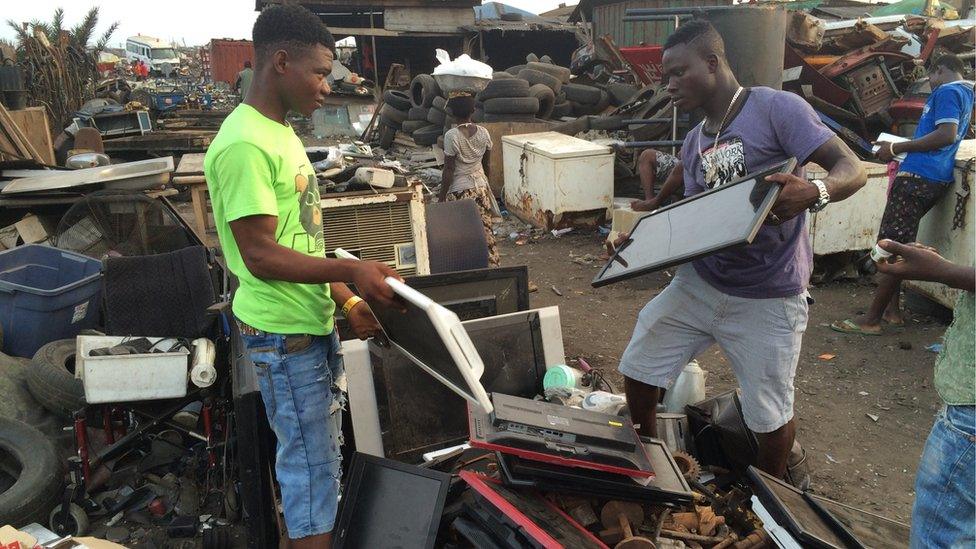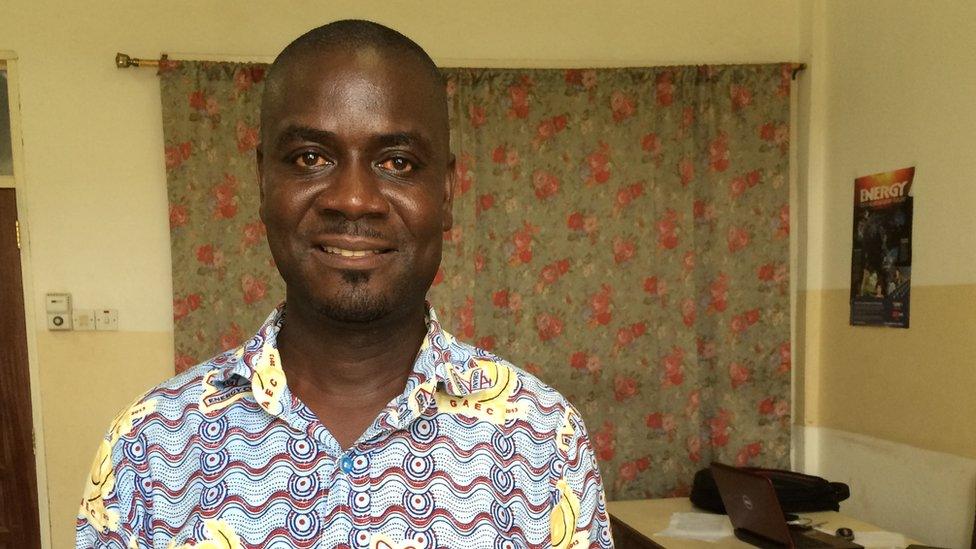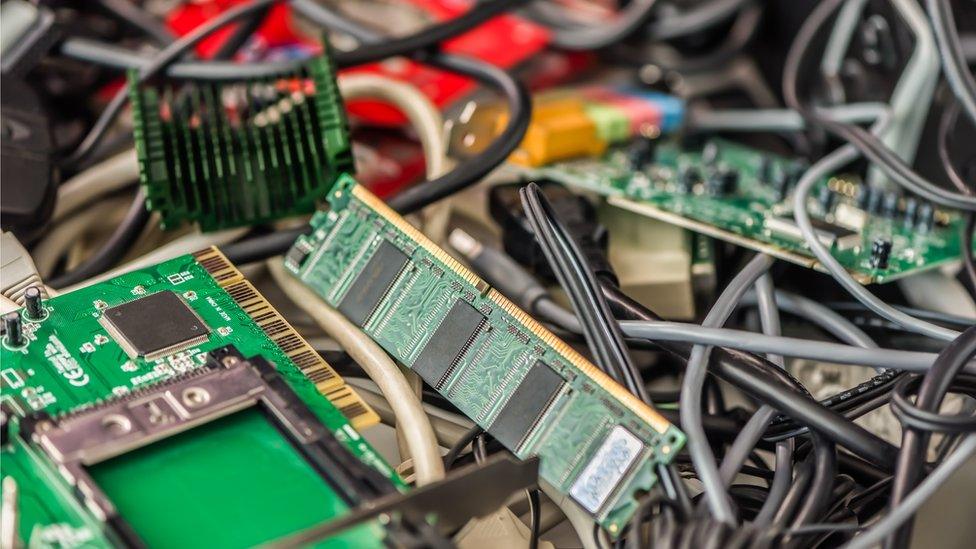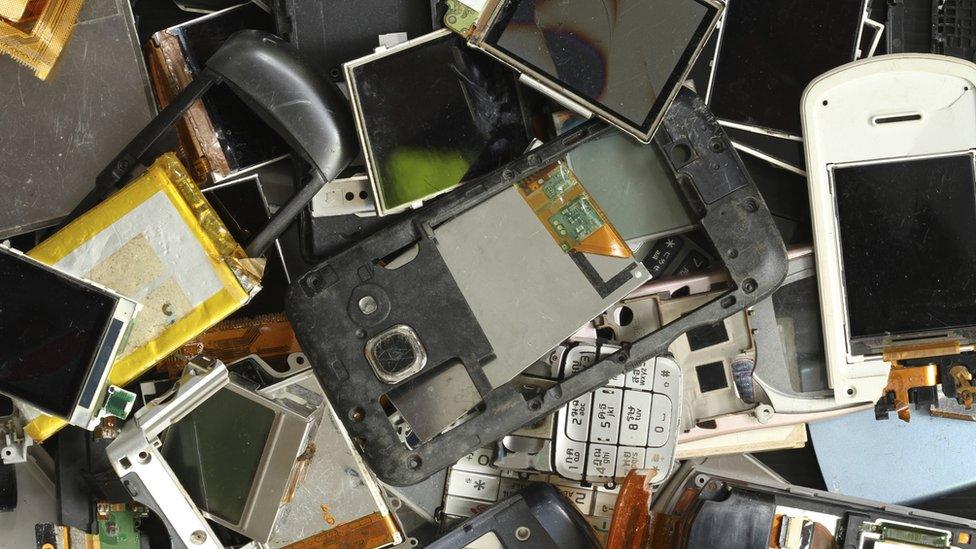Where many of our electronic goods go to die
- Published

Sam Sandu says recycling e-waste helps him make a good living
At a vast dumpsite in the west of Ghana's capital Accra, small fires burn among piles of old computers, television screens and laptops, throwing plumes of thick black smoke into the air.
Around them workers pick out motherboards, valuable metals and copper wires, burning away the plastic casings as they go - filling the air with toxic fumes.
This is one of the biggest dumps for electronic waste in the world, and among the most polluted places on earth.
Every year hundreds of thousands of tonnes of e-waste find their way here from Europe and North America, where they are stripped of their valuable metals in the crudest form of recycling.
For many it's a lucrative business in a country where nearly a quarter of people live below the poverty line.
"It's an instant job," said Sam Sandu, a scrap dealer who works on the site. "Today you work on it, and you can get your money the same day."
But experts warn the toxins present in the waste are slowing poisoning the workers, as well as spreading pollution into the soil and atmosphere.

Agbogbloshie is one of the world's biggest sites for electronic waste
The BBC's Ed Butler looks around Ghana's massive electronic waste dump.
"Mercury, lead, cadmium, arsenic - these are the four most toxic substances [in the world], and these are found in e-waste residues in very large quantities," explains Atiemo Sampson, an environmental researcher at the Ghana Atomic Energy Commission, who has conducted several studies of the Agbogbloshie site.
Range of illnesses
According to the International Labour Organisation, long-term health studies on e-waste workers have yet to be conducted, so there is little data on the numbers of people who have fallen ill or even died as a result of working with e-waste.
But exposure to these toxins are known to cause a whole range of illnesses from cancers to heart disease to respiratory illnesses.
"The consequences are already quite apparent," says Atiemo Sampson. "We are not waiting for 10 years or 20 years, the effects are already happening within the Ghanaian community."
Analysts estimate the world will produce 93 million tonnes of e-waste this year alone - an ever-growing volume that is the result of the built-in obsolescence of many high-end electronic products.

Researcher Atiemo Sampson says electronics companies must take responsibility for the toxic mess created in Ghana
Much of it will find its way to a handful of e-waste dumps in Africa and Asia, rather than being recycled in the country in which it was sold.
Manufacturers' role
Campaigners in Ghana say some of these exports are simply illegal - infringing EU regulations that ban the export of broken electronic goods to developing countries for dumping.
However, the majority are believed to be legal imports of working second-hand goods, sent over to fuel the surging demand for cheap electronics in developing economies like Ghana.
Yet regardless of how it got here, Atiemo Sampson believes electronics producers have a responsibility to help clean up the mess their products helped create.
"I agree that we have a technology gap that must be filled," he says. "But across the world there is a growing acceptance that the producer of the equipment must bear responsibility for 'end of life' management.
"They should be investing in collections systems, in recycling systems in Africa. It is morally right and legally right."
So why aren't the electronics manufacturers doing more?
Walter Alcorn is the vice president of environmental affairs at the Consumer Technology Association - the trade body for tech firms in the US.
He says "take-back" programmes are in place to encourage consumers to return their old gadgets for recycling and prevent them from becoming waste or finding their way to developing countries.

Tech firms say they are phasing out dangerous chemicals and heavy metals
But he says the real difference will be made as producers phase out the use of dangerous chemicals and heavy metals.
"We're working through a legacy period, with legacy products that are 10 or 20 years old," he says. "Ultimately over the next 10 or 20 years we'll see this thing go away.
"Our primary responsibility as an industry is to produce products that are environmentally safe and do not cause these problems down stream."
'Enormous problem'
But in the short-term at least, the e-waste at sites like Agbogbloshie continues to pile up.
And experts like materials scientist Hywel Jones of Sheffield Hallam University in the UK says the solution to the e-waste problem has to be multi-faceted.

Since 1994, 15 billion mobile phones have been made
His 'What's In My Stuff?' project aims to educate the public about the materials found in a typical smartphone, a move that he hopes will create more ethically-minded customers.
But he says companies and governments need to be engaged too.
"Two billion mobile phones are manufactured every year - more than 15 billion manufactured since 1994, and that's not counting cameras, laptops and televisions," he says.
"We have an enormous problem and we're starting very late in the day to fix it. Science and technology will get us there, but alongside consumer and human behaviour."